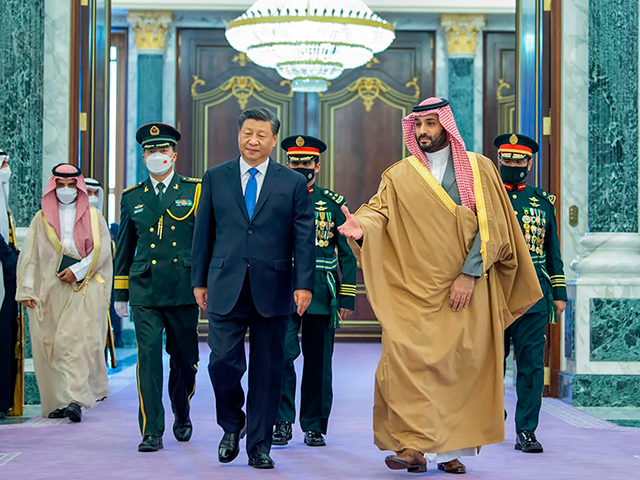The governments of Saudi Arabia and China published a lengthy joint statement on Friday detailing the topics of discussion between King Salman and visiting Chinese dictator Xi Jinping that revealed an agreement “welcoming” Saudi involvement in the Belt and Road Initiative (BRI).
The plan is part of a much larger set of agreements ranging from language instruction to diplomatic support on the international stage, including a cushy oil importing deal granting the Communist Party a discount on crude. The agreements follow Xi receiving an ostentatious welcome upon his arrival in Riyadh on Wednesday featuring elaborate jet flyovers, a military band, and “traditional sword-holding etiquette.”
The BRI is a global infrastructure plan in which China offers predatory loans to poor countries to be used to pay Chinese companies to build state-of-the-art new ports, highways, and other transportation infrastructure. China promises the countries that the projects will create jobs and facilitate commerce in the long term. In reality, China has imported Chinese workers into impoverished regions of countries such as Kenya, Rwanda, and Sri Lanka, crowding locals out of the job market, and seized the projects when the countries involved could not pay their debts, eroding the countries’ sovereignty.
Among the most destitute BRI partners is Sri Lanka, which lost control of its key Hambantota port for nearly 200 years to China after defaulting on its BRI debts. Sri Lanka fell into a severe economic crisis this year leaving its populace with nearly no access to gasoline, diesel, liquified natural gas, tea, several major food products, and basic medical goods, resulting in widespread protests that toppled former President Gotabaya Rajapaksa.
A report published last year by the AidData project at the College of William & Mary in Virginia accused China of using the BRI “to establish a dominant position in the international development finance market,” competing with other sources of international aid that do not offer deals as predatory or risky as China’s.
Saudi Arabia does not appear to be a particularly viable candidate for BRI loans, as its economy is booming and it does not appear to be in any immediate need of infrastructure projects – leaving unclear how Riyadh would participate in the program. On Friday, the two countries’ joint statement suggested that Saudi companies could join Chinese companies in taking on BRI projects in target countries, creating job and contract opportunities for Saudis. In other words, China would allow Saudi companies to partake in the exploitation of BRI victim countries.
“The two sides stressed the importance of deepening joint cooperation in regard to ‘Belt and Road Initiative,’ welcoming the related Saudi companies[‘] involvement in various energy and investment partnerships within the framework of ‘Belt and Road Initiative,'” the Chinese-Saudi joint statement announced, “enhancing the Kingdom’s location as a regional center for Chinese companies in producing and exporting the products of energy sector, as well as the joint investment in energy projects in the countries of the region and energy consuming countries in Europe and Africa.”
“All of this will contribute in developing Saudi local content, and achieve self-sufficiency for China in the field of petrochemicals through its related investment in the Kingdom,” it affirmed.
King Salman and Xi reportedly agreed on a “harmonization plan” between the BRI and “Vision 2030,” an ambitious project implemented by Crown Prince Mohammed bin Salman, the nation’s de facto ruler, to help diversify the Saudi economy and make it less totally reliant on oil. Vision 2030 appears in many ways to be inspired by China’s BRI and its broader goal to make the Communist Party the dominant global power by 2050. In their joint statement, the two countries did not specify individual projects to “harmonize” their goals, but suggested they would work on “employing integrated advantages and deepening practical cooperation between the two sides so as to obtain mutual benefits and common development.”
“The two sides agreed to enhance the work to benefit from the available trade and investment opportunities, intensify the capacity of aircraft carriers, motivate private sectors investment partnerships in both countries,” the statement continued, “consolidate efforts to create attractive, supportive, and incentive investment environment within the framework of the Kingdom’s Vision 2030 and ‘Belt and Road Initiative.'”
The statement listed developing a more self-sustaining automotive industry and improving supply chains and water supply projects among the potential projects.
In a separate readout on Xi’s meetings in Saudi Arabia, the Chinese Foreign Ministry emphasized the mutual desire to “earnestly synergize China’s Belt and Road Initiative and Saudi Arabia’s Vision 2030.”
“China will increase communication and coordination with Saudi Arabia on energy policy, expand the scale of crude oil trade, enhance cooperation on exploration and development, and deliver on the Sino-Saudi Gulei Ethylene Complex Project and other large-scale energy cooperation projects,” the readout promised.
Xi is in Saudi Arabia to attend two regional conferences in addition to meeting with the Saudi leaders: a summit bringing China together with Gulf states and a broader event for Arab countries. The Saudi Press Agency (SPA) reported this week that Xi is expected to sign multiple trade deals with Riyadh worth nearly $30 billion.

COMMENTS
Please let us know if you're having issues with commenting.